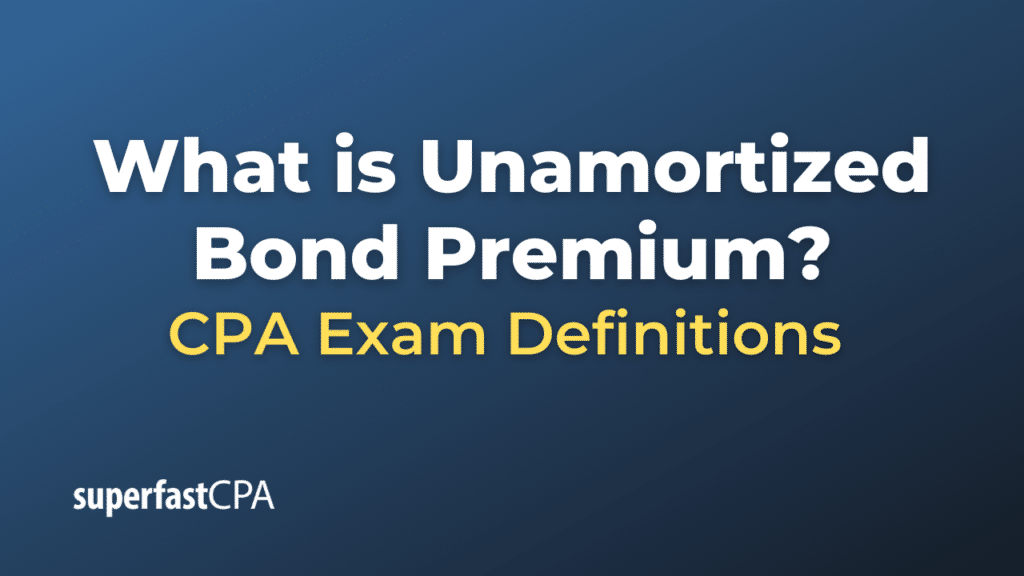Unamortized Bond Premium
“Unamortized Bond Premium” refers to the portion of a bond premium that has not yet been amortized (or expensed) over the life of the bond. To fully understand this concept, let’s first discuss the basics of bond issuance at a premium.
Bond Issuance at a Premium:
When a bond is issued for more than its face (or par) value, the difference between the issuance price and the face value is termed as the bond premium. The premium typically arises when the stated interest rate on the bond is higher than the prevailing market interest rate. This makes the bond more attractive to potential buyers, and they are willing to pay more than the face value to earn a higher interest rate.
Similar to a bond discount, the bond premium is not treated as an income all at once. Instead, it’s amortized over the life of the bond. As the bond matures, the unamortized bond premium will decrease.
Unamortized Bond Premium:
This represents the cumulative portion of a bond premium that has yet to be amortized. Over time, as the bond approaches its maturity date, the unamortized bond premium will reduce to zero.
Accounting Treatment:
The bond premium increases the carrying value of the bond liability on the balance sheet. As the premium is amortized, it reduces the carrying amount of the bond. The amortization of the bond premium also results in a reduction of the interest expense on the income statement.
Example of Unamortized Bond Premium
Let’s provide an example that showcases the issuance and subsequent amortization of a bond premium.
Example: Bond Issued at a Premium
Imagine that DEF Corporation wants to raise capital and decides to issue a 5-year bond with a face (or par) value of $100,000. The bond offers an annual interest rate (coupon rate) of 8%. However, the current market interest rate for similar bonds is only 6%. Because DEF’s bond offers a higher interest rate, investors are willing to pay more for it.
The bond is sold for $105,000, which means DEF receives $5,000 more than the bond’s face value. This extra $5,000 is considered the bond premium.
For simplicity, let’s use straight-line amortization (though, in reality, the effective interest method is more common). The annual amortization of the bond premium would be:
Bond Premium ÷ Bond Life = Annual Amortization Amount
$5,000 ÷ 5 years*\ = $1,000 per year
Yearly Amortization of Bond Premium:
| Year | Beginning Unamortized Premium | Amortization for the Year | Ending Unamortized Premium | Net Carrying Value |
|---|---|---|---|---|
| 1 | $5,000 | $1,000 | $4,000 | $104,000 ($100,000 + $4,000) |
| 2 | $4,000 | $1,000 | $3,000 | $103,000 ($100,000 + $3,000) |
| 3 | $3,000 | $1,000 | $2,000 | $102,000 ($100,000 + $2,000) |
| 4 | $2,000 | $1,000 | $1,000 | $101,000 ($100,000 + $1,000) |
| 5 | $1,000 | $1,000 | $0 | $100,000 |
At Issuance:
- Debit: Cash: $105,000
- Credit: Bonds Payable: $100,000
- Credit: Premium on Bonds Payable: $5,000
Each Year (For Annual Interest Payment & Premium Amortization):
- Debit: Interest Expense: $7,000 [(8% of $100,000) – $1,000 premium amortization]
- Debit: Premium on Bonds Payable: $1,000
- Credit: Cash: $8,000 (8% of $100,000)
By the end of Year 5, the entire bond premium has been amortized, and the bond’s carrying value on the balance sheet matches its face value.













